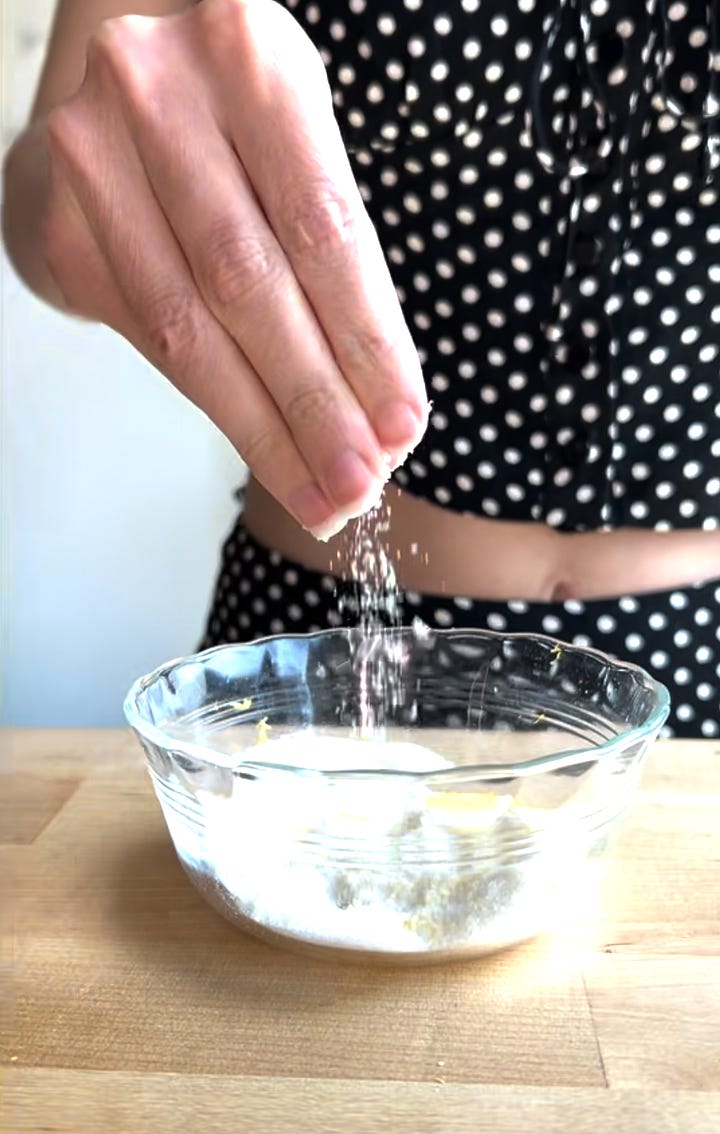A little-known fact about me is that I’m not particularly fond of lemon desserts. Perhaps it’s because of a pack of lemon pudding I devoured before a childhood gymnastics routine—it did not sit well with me. Since then, I’ve avoided lemons in sweets. However, despite my personal taste, I find myself baking with lemons frequently because people love them, and I’m genuinely fascinated by the science behind it. There’s something magical about rubbing lemon zest into sugar. That moment when the kitchen fills with the bright scent of citrus and sweetness is not just baking; it’s a little bit of chemistry at your fingertips.
This month, I’m diving deep into the science of lemons, from their bright, zippy acidity to the essential oils hidden in their peel. We’ll start with one of the simplest and most fragrant processes in the kitchen: lemon sugar. This exploration is not just about flavor; it’s about unlocking volatile compounds, understanding surface area, and creating a pantry staple that can elevate everything from shortbread to whipped cream. Let’s discover how sugar acts as a flavor extractor, how limonene transforms a recipe, and why this small act of zesting is more significant than it seems.
Lemon Sugar: The Science Behind That Bright, Citrus-Packed Flavor 🍋+🧂=✨
Let's examine what happens when you rub lemon zest into sugar, a technique used in everything from lemonade to cookies and cakes to enhance lemon flavor.
Here's the science behind it: The outer yellow part of the lemon peel, known as the flavedo, contains oil glands filled with limonene, a citrus compound that gives lemons their distinctive aroma.
These oils are not water-soluble, meaning they do not dissolve easily in liquids like lemon juice. However, they can bind to fats and can be released through abrasion.
When you rub lemon zest into sugar with your fingers, you perform the following actions:
Break open the tiny oil glands in the peel.
Release the fragrant essential oils.
Trap those volatile compounds in the sugar crystals, creating an aromatic, flavor-packed mixture.
This process is a form of mechanical extraction, a gentle, kitchen-scale method similar to cold-pressing citrus oil.
Why Not Just Use Juice?
Lemon juice contains acidity and water, not much oil. If you're relying only on juice, you're missing out on the intense citrus aroma and complexity of the zest oils.


🍋 Lemon Sugar Recipe
Ingredients:
1 cup granulated sugar
Zest of 1–2 lemons (organic if possible and wash well)
Instructions:
Use a microplane or fine grater to zest only the yellow part of the lemon peel. Avoid the bitter white pith underneath.
Combine the zest and sugar in a bowl.
Now the fun part: Rub the zest into the sugar using your fingertips. This friction breaks open the oil glands in the zest, releasing citrus oils that bind to the sugar crystals. This transforms regular sugar into a fragrant, flavorful lemon sugar.
For even more aroma, let the lemon sugar sit uncovered for 30 minutes to allow the oils to infuse deeply.
Store in an airtight container at room temperature for up to one week, or freeze for longer storage.
Where to Use Lemon Sugar:
Lemon sugar cookies
Muffin or scone toppings
Citrus glazes
Rimming cocktail glasses
Stirring into tea
Brightening shortbread dough
Or as any sugar replacement in a recipe where you want a hint of lemon.
🛠️ Tools to Harness Lemon's Potential
Zesters and Graters: Essential for finely grating lemon zest to release essential oils.
Citrus Peelers: Designed to remove the peel without the bitter pith, ideal for garnishes and infusions.
Lemon Juicers: Efficiently extract juice while preserving the integrity of the peel for further use.
Sources
Di Vaio, C. et al. (2010) – Volatile composition of lemon essential oils
https://doi.org/10.1016/j.flora.2010.03.004
Saleem, M. & Saeed, A. (2020) – Antibacterial activity of limonene-rich citrus extracts
https://doi.org/10.1016/j.jksus.2020.02.001
Zou, Z. et al. (2018) – The chemical composition and health effects of lemon peel polyphenols
https://doi.org/10.1016/j.foodchem.2017.10.140
Baldi, A. et al. (1995) – Flavonoid structures and bioactivity in citrus peel extracts
[Original study not digitized; reference from review material]
ScienceDirect – “Lemon” topic overview
https://www.sciencedirect.com/topics/food-science/lemon
The Genus Citrus (2018), Elsevier
https://www.sciencedirect.com/book/9780128121634/the-genus-citrus
Want to learn more? Have a questions? Reply and let me know—I always love talking about the science behind baking.
Stay Sweet,
Sarah @HalfBatchBaking





